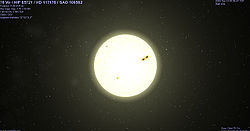
Back 70 Virginis AST 70 Virginis Catalan 70 Virginis German 70 Virginis Spanish ۷۰ دوشیزه Persian 70 Virginis Finnish 70 Virginis French 70 Virginis ID 70 Virginis Italian おとめ座70番星 Japanese
| Observation data Epoch J2000.0 Equinox J2000.0 | |
|---|---|
| Constellation | Virgo |
| Right ascension | 13h 28m 25.8086s[1] |
| Declination | +13° 46′ 43.638″[1] |
| Apparent magnitude (V) | +4.97[2] |
| Characteristics | |
| Spectral type | G4 V-IV[3] |
| U−B color index | 0.26 |
| B−V color index | 0.714±0.007[2] |
| V−R color index | 0.39 |
| R−I color index | 0.36 |
| Variable type | none |
| Astrometry | |
| Radial velocity (Rv) | 4.44±0.13[2] km/s |
| Proper motion (μ) | RA: −235.951(75) mas/yr[1] Dec.: −575.969(32) mas/yr[1] |
| Parallax (π) | 55.2511 ± 0.0779 mas[1] |
| Distance | 59.03 ± 0.08 ly (18.10 ± 0.03 pc) |
| Absolute magnitude (MV) | +3.70±0.01[4] |
| Details | |
| Mass | 1.12[5] M☉ |
| Radius | 1.9±0.1[6] R☉ |
| Luminosity | 2.92±0.03[7] L☉ |
| Surface gravity (log g) | 3.58 cgs |
| Temperature | 5,406±64[7] K |
| Metallicity [Fe/H] | −0.06[7] dex |
| Rotational velocity (v sin i) | 4.83[8] km/s |
| Age | 7.9[7] Gyr |
| Other designations | |
| Database references | |
| SIMBAD | data |
| Exoplanet Archive | data |
| ARICNS | data |
70 Virginis is a binary[10] star located 59[1] light years from the Sun in the equatorial constellation of Virgo, near the northern constellation border with Coma Berenices. 70 Virginis is its Flamsteed designation. The star is visible to the naked eye as a faint, yellow-hued point of light with an apparent visual magnitude of +4.97.[2] It is drifting further away with a heliocentric radial velocity of +4.4 km/s[2] and has a high proper motion, traversing the celestial sphere at the rate of 0.621 arc seconds per annum.[11]
This object has a stellar classification of G4 V-IV,[3] being rather unusually bright for a main sequence star of its type and thus may be just starting to evolve into the subgiant phase. It is an estimated 7.9[7] billion years old and is spinning with a projected rotational velocity of 4.8 km/s.[8] The star has 1.12[5] times the mass of the Sun and 1.9[6] times the Sun's radius. It is radiating 2.92[7] times the luminosity of the Sun from its photosphere at an effective temperature of 5,406 K.[7] The metallicity – a term astronomers use to describe the abundance of elements heavier than helium – is near solar.[7]
In 2011, a star was discovered 2.86 arcseconds away from the primary, and is likely associated with 70 Virginis. Based on its properties, it has a spectral type later than M5V, and has a mass of about 8% that of the Sun.[10] There is also an L-type brown dwarf 42.7 arcseconds away from the primary, but it is unclear whether this is bound to the system.[10]
In 1996, 70 Virginis was discovered to have an extrasolar planet in orbit around it.[12] There is also an orbiting dusty disc with an average temperature of 153 K located at a mean distance of 3.4 AU from the star.[13]
- ^ a b c d e Cite error: The named reference
Gaia DR3was invoked but never defined (see the help page). - ^ a b c d e Cite error: The named reference
Anderson2012was invoked but never defined (see the help page). - ^ a b Cite error: The named reference
Strassmeier2017was invoked but never defined (see the help page). - ^ Holmberg; et al. (2009). "HD 117176". Geneva-Copenhagen Survey of Solar neighbourhood III. Retrieved 2010-02-02.
- ^ a b Cite error: The named reference
apjss192_1_2was invoked but never defined (see the help page). - ^ a b Gerard T. van Belle & Kaspar von Braun (2009). "Directly Determined Linear Radii and Effective Temperatures of Exoplanet Host Stars". The Astrophysical Journal. 694 (2): 1085–1098. arXiv:0901.1206. Bibcode:2009ApJ...694.1085V. doi:10.1088/0004-637X/694/2/1085. S2CID 18370219. (web Preprint)
- ^ a b c d e f g h Cite error: The named reference
apj771_1_40was invoked but never defined (see the help page). - ^ a b Cite error: The named reference
MartínezArnáiz2010was invoked but never defined (see the help page). - ^ Cite error: The named reference
Simbadwas invoked but never defined (see the help page). - ^ a b c Fontanive, C.; Rice, K.; Bonavita, M.; Lopez, E.; Muzic, K.; Biller, B. (2019). "A high binary fraction for the most massive close-in giant planets and brown dwarf desert members". Monthly Notices of the Royal Astronomical Society. 485 (4): 4967–4996. arXiv:1903.02332. Bibcode:2019MNRAS.485.4967F. doi:10.1093/mnras/stz671.
- ^ Cite error: The named reference
Lepine2005was invoked but never defined (see the help page). - ^ Cite error: The named reference
Marcy1996was invoked but never defined (see the help page). - ^ Cite error: The named reference
Trilling2008was invoked but never defined (see the help page).
© MMXXIII Rich X Search. We shall prevail. All rights reserved. Rich X Search
